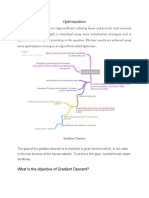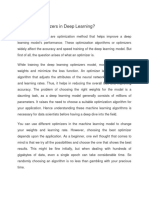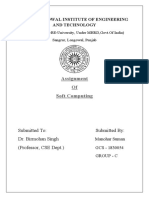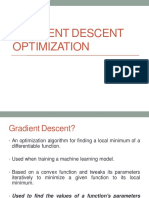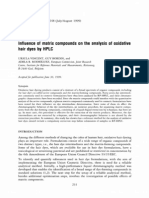0% found this document useful (0 votes)
9 views13 pagesOptimization Gradient Descent
The document discusses various optimization algorithms used in neural networks, focusing on Gradient Descent and its variants, including Batch Gradient Descent, Stochastic Gradient Descent, and Mini-Batch Gradient Descent. It highlights the objectives, advantages, and drawbacks of these methods, as well as advanced optimizers like Adagrad, Adadelta, RMSProp, and Adam. Additionally, it addresses issues related to exploding and vanishing gradients, providing potential solutions for these problems.
Uploaded by
tirthankar.sardar.cseds.2022Copyright
© © All Rights Reserved
We take content rights seriously. If you suspect this is your content, claim it here.
Available Formats
Download as DOCX, PDF, TXT or read online on Scribd
0% found this document useful (0 votes)
9 views13 pagesOptimization Gradient Descent
The document discusses various optimization algorithms used in neural networks, focusing on Gradient Descent and its variants, including Batch Gradient Descent, Stochastic Gradient Descent, and Mini-Batch Gradient Descent. It highlights the objectives, advantages, and drawbacks of these methods, as well as advanced optimizers like Adagrad, Adadelta, RMSProp, and Adam. Additionally, it addresses issues related to exploding and vanishing gradients, providing potential solutions for these problems.
Uploaded by
tirthankar.sardar.cseds.2022Copyright
© © All Rights Reserved
We take content rights seriously. If you suspect this is your content, claim it here.
Available Formats
Download as DOCX, PDF, TXT or read online on Scribd
/ 13





